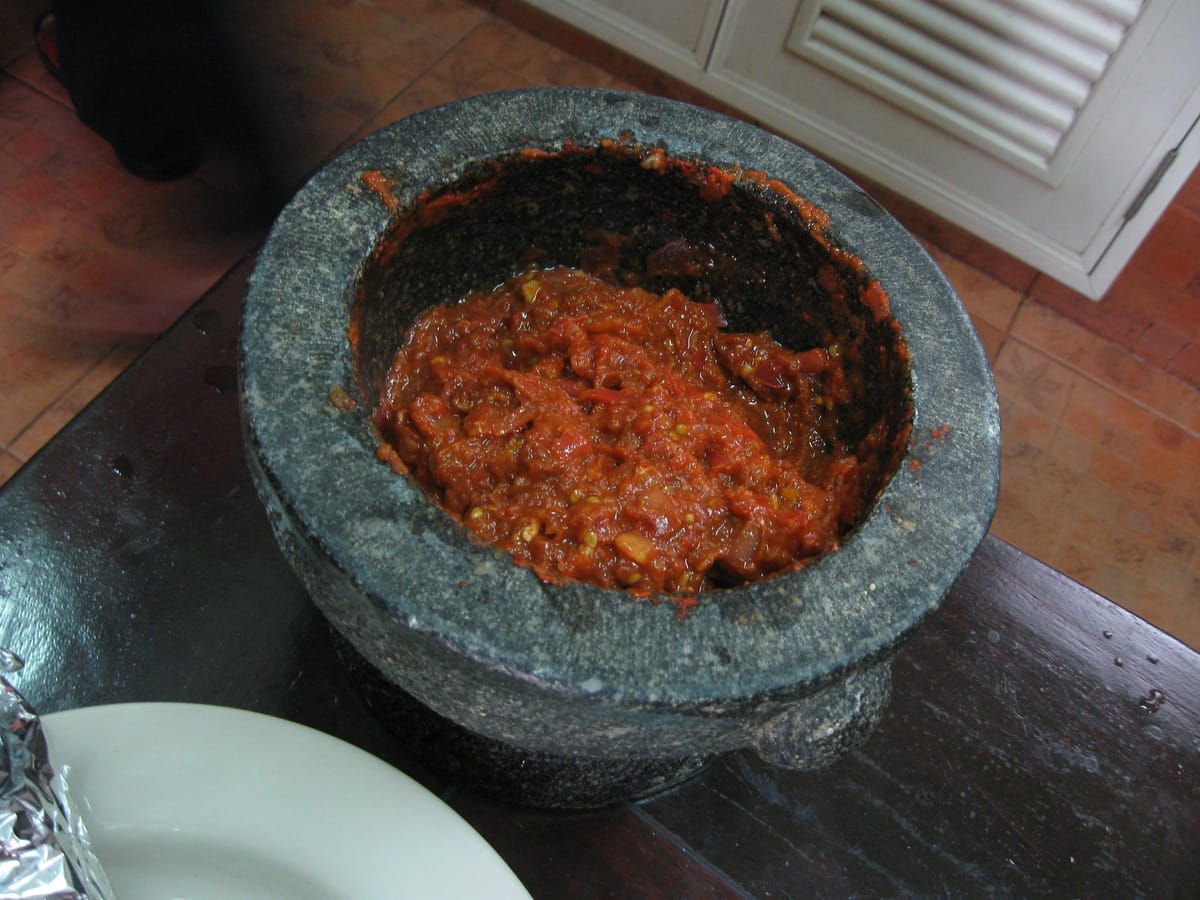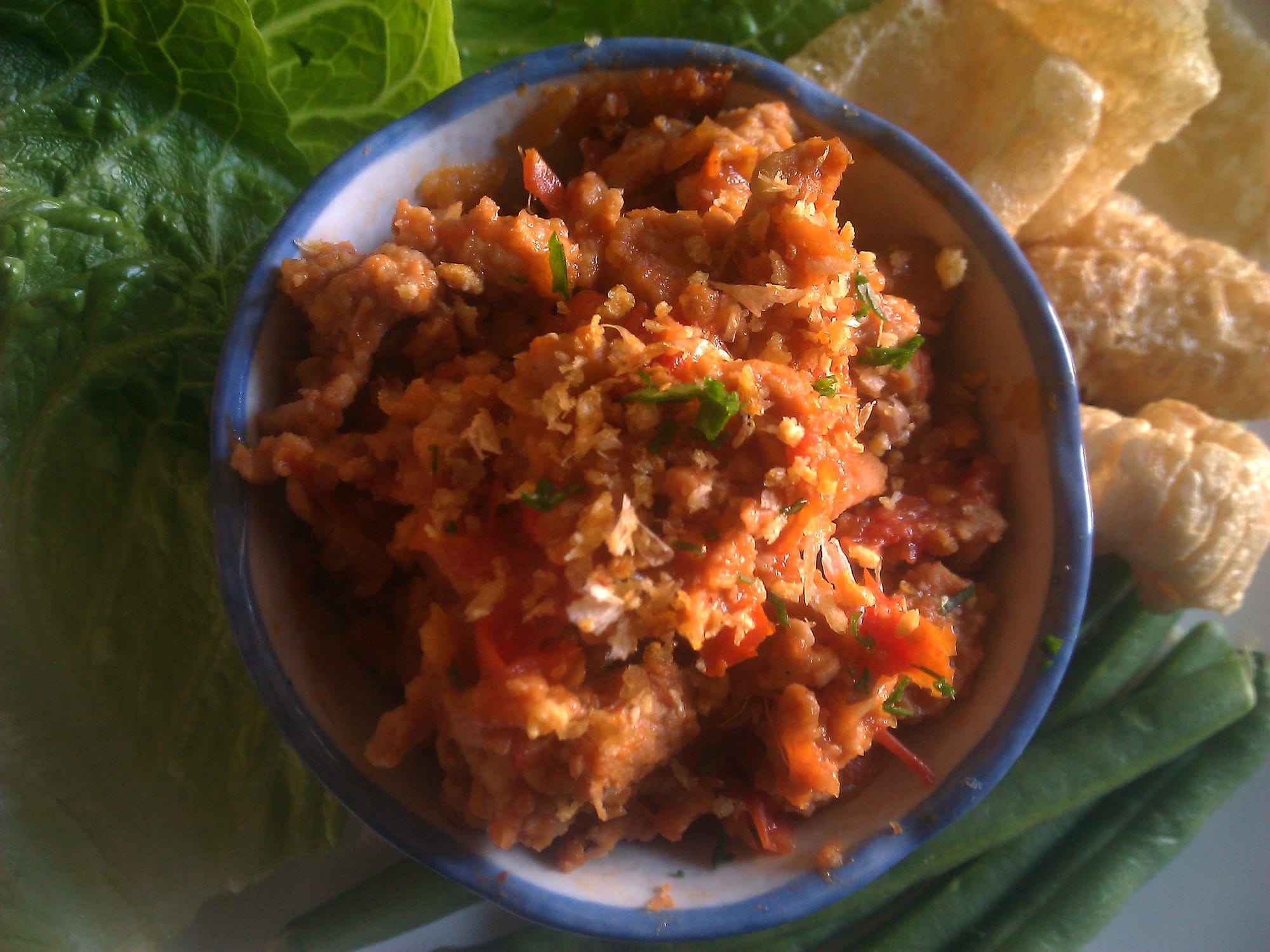Of North and South

My paternal grandmother hailed from the north country.
That made her a descendent of the Lanna Kingdom, and in photographs from her younger years, you can see hints of that bloodline in her pale skin and elongated features, Chinese-like, but not completely. Years later, having moved to Bangkok and married my grandfather, she made sure the food her housekeepers prepared agreed with her northern Thai palate. The immediate providence of mountains and jungles in the north calls for intense herbal flavors and broth-like curries, mostly without coconut milk. Small game meats supplement chicken and river finds like snails, frogs, and freshwater fish. Fruits, dried flowers, and aromatic leaves are stirred into spicy soups, some made even bolder by Indian spices that came by way of old trade routes through Burma.
Northern food is not native to my grandmother’s housekeeper, an Isan woman from the northeastern plateaus. It is historically the poorest part of the country, an unlucky territory victimized by nature’s yearly whims, from droughts to monsoon floods, and from being caught between swords and bullets—taken from the Khmer by Laotian kings, only to be made a vassal state to the Siamese, and then split across the Mekong River after the 1893 Franco-Siamese War. Isan food is usually considered the spiciest in Thailand; the spicier it is, the easier it is to spread the flavor across a bowl of rice when little else could be afforded.
When my grandmother passed away, her housekeeper came to work for my parents. My mother is Bangkok-born. To many in the capital, the foods of the north and northeastern provinces, with its many crossover dishes, blur into the same fog of vaguely tolerable spiciness (sab, as they’re often described). It’s hard to call the foods in the central provinces mild, but spiciness in the region tends to be less indomitable. Coconut milk and cream arriving from the plentiful southern seaside help round out most curries. Chinese noodles are more ubiquitous, as are much less piquant ethnic Chinese meals. Then there are the inheritors of what’s loosely called royal cuisine, with dishes that evolved from more elaborate palace versions carrying on the tradition of palatal subtleties and cosmpolitanism. These were the aesthetics to which my grandmother’s housekeeper, now my parents’, had to lean toward in her repertoire, owing to my mother’s city-folk preferences.
Some might see a woman from the north having to cater to Bangkok tastes as an extension of the tale of North and South, of class and culture. The Lanna Kingdom became part of Siam only in 1892, an alliance to break free from Burmese rule. Prosperous Chiang Mai thrives in the shadow of Bangkok, where resources and wealth concentrate; the Isan provinces, meanwhile, has historically suffered in everyone else’s shadow. Over time, resentment and fears simmered, culminating most recently in the 2010 riots in Bangkok, where supporters of an exiled prime minister with significant following in the north and rural northeast clashed with supporters of the old guard and, eventually, the army. Hundreds died. Buildings at the heart of the nation’s commercial districts burned. It would be easy to see fissures far too jagged for repair.
A look at the menu of almost any formal Thai restaurant suggests hope for otherwise. Foods from every region are available in Bangkok—all things and people flow to the capital—and the distinction between country and city cuisine has narrowed. A typical Bangkok menu now tends toward overwhelming inclusion, cherry-picking from the wide breadth of Thai regional foods. Larbs and curry noodles from the north coexist peacefully with central-region soups and seafood dishes from the South. Diners routinely embrace the havoc from som tam, the green papaya salad from the northeast and conqueror of the most fortified gastrointestinal tracts, and procure northern sausages by the kilo at mall booths.
Likewise, the flow of those returning home from Bangkok, as well as demands for the familiar by both foreign and Thai tourists, mean foods from other regions are now part of the norm in the north. A recent jaunt showed me that, outside of independent street stalls and single-dish shops, purely northern cuisine has increasingly become a specialty in its own region. All-encompassing restaurants serving northern nam priks alongside super-fried dishes—a glaring Bangkok inclination—make up a large part of the culinary landscape, not to mention the increased proliferation of steakhouses, sushi bars, and Korean barbecue. In a country a little smaller than Texas, Thai cuisine has become less region-specific and more kitchen-specific. At the table, there’s no such thing as politics.
In my parents’ household, it’s not extraordinary for my mother’s television to favor shows friendly to certain political parties while her housekeeper’s kitchen radio is set to an opposing party’s station. Yet, in the evening, the dishes that arrive show no such divisions. My mother has taken a liking to many of the northern dishes, with her housekeeper having perfected milder versions. When I visit Bangkok, I hang around in the kitchen, taking notes. One day, I learn how to make northern dishes, like nam prik ong, a spicy dip with pork. The next, I steam a seafood curry wrapped in banana leaves, a central and southern specialty.
I’d like to think that those who sit down to eat the same meals—to take in that of another, a communion—will find fewer reasons to quarrel. I hope the detente lasts.

Nam Prik Ong Recipe
You can control the spiciness by the number of dried chilies—drop to five if you are too delicate a creature. Textured vegetable protein can be used as a substitute for the pork, if you really must, but think hard before proceeding so recklessly. I’ve made a version with ground turkey that was pretty good.
For dip
- 6 to 9 dried Thai chilis
- 1/2 cup diced shallots
- 2 cilantro roots, minced
- 6 cloves garlic, minced
- 2 tablespoons minced lemongrass
- 1 teaspoon Thai shrimp paste (kapi)
- 1 pinch salt
- 1 cup roughly chopped cherry tomatoes
- 3 to 4 tablespoons vegetable oil
- 1/2 pound ground pork
- 1 teaspoon fish sauce, plus more to taste
- 1 tablespoon roughly chopped palm sugar, plus more to taste
For garnish
- 1 teaspoon minced garlic
- 1 teaspoon chopped cilantro leaves
Accompaniments
- Cucumber slices
- Romaine lettuce leaves
- Trimmed green beans
- Halved Thai eggplants
- Trimmed banana blossoms
- Pork rinds
- Cut the dried chilies lengthwise and shake to deseed. Place them in a bowl with boiling water to cover and hydrate for 15 minutes, then drain.
- To make the paste in a mortar and pestle: Pound ingredients until thoroughly mashed and semi-liquified. If you have a small mortar, you can pound the tomatoes separately and then combine them with the rest of the paste.
- To make the paste in a food processor: Add all paste ingredients but tomatoes to processor bowl. Process until ingredients are finely chopped and semi-liquified. Add tomatoes and pulse eight to 10 times, until incorporated but not soupy.
- Heat 2 to 3 tablespoons of oil at medium heat in a 10-inch or 12-inch saucepan. Add curry paste and fry for 1 minute to release its fragrant oils. Add pork and cook, stirring occasionally, until meat is browned.
- Add fish sauce and palm sugar, then stir to incorporate, adding more to taste. Simmer at low heat until all liquid has evaporated and sauce is thickened, about 15 to 20 minutes. It should remind you a bit of your Italian grandmother’s Bolognese sauce.
- Meanwhile, in a small saucepan, fry minced garlic in a tablespoon of oil until lightly golden.
- Serve in a bowl as a dip for the accompaniments, garnished with the fried garlic and cilantro. It’s perfectly fine if you decide to dip chips into it, but pork rinds are traditionally preferred.
